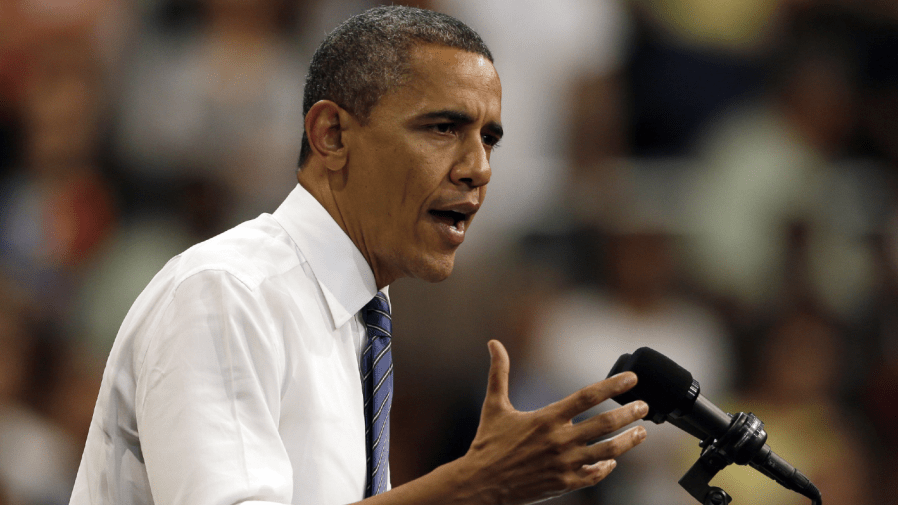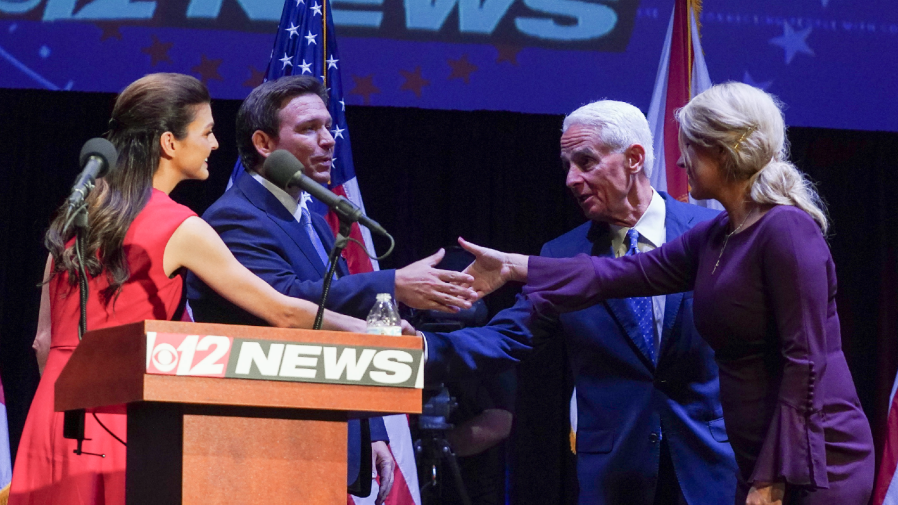How Florida became a conservative bastion
EDITOR’S NOTE: This is the first in a five-part series called “How Florida got so conservative.”
Florida has become the nerve center of the modern Republican Party.
Once the nation’s largest and most volatile swing state, Florida has lurched to the right in recent years, becoming a mecca for the GOP’s most influential luminaries and wealthiest donors.
Republicans now hold supermajorities in the state legislature, and Gov. Ron DeSantis (R) has solidified his grip on the reins of political power in the state, turning Florida into a laboratory for conservative policy experiments. For the first time since Reconstruction, there’s not a single Democrat in statewide elected office.
But Florida’s transition from coveted political battleground to the premier haven of modern conservatism has been decades in the making, owing to a perfect storm of demographic changes, Republican power plays, pandemic politics and Democratic missteps, according to more than a dozen strategists, experts and officials interviewed by The Hill.
“Republicans focused on the ultimate goal,” said Fernand Amandi, a Miami-based Democratic pollster who helped former President Barack Obama win the state in 2008 and 2012. “They thought things out in 10-year cycles. They built a permanent campaign apparatus. They started recruiting candidates to run for local office and springboarding them into higher office. They registered voters and managed the margins.”
“Florida is now mecca for MAGA,” he added. “It is the one safe space and lighthouse for Republican MAGA voters across the United States.”
From Obama to Trump

File photo from 2012. (AP Photo/Lynne Sladky)
It was just a decade ago, on the heels of Obama’s reelection victory, that Democrats saw Florida as politically promising.
Obama won Florida’s electoral votes for the second consecutive presidential election in 2012, nearly tying then-GOP presidential nominee Mitt Romney for the state’s conservative-leaning Cuban American vote, and Florida was only becoming larger and more diverse.
“It seemed like things were actually going the other way at one time,” Aubrey Jewett, a political science professor at the University of Central Florida, said. “When Obama won the state, this seemed to be, at that time, confirmation of the ‘demography is destiny’ idea — as Florida gets less white, it’s going to be more Democratic.”
Instead, Republican nominee Donald Trump defeated Democratic nominee Hillary Clinton in 2016, and Trump won again four years later — solidifying the idea Florida had gone red. In 2018, Republican Ron DeSantis was elected governor, and he won a huge reelection victory in 2022.
“The last several years, with Trump and then DeSantis, seemed to bust that whole thing wide open,” Jewett said.
With Trump’s move to Florida after his presidency, the two favorites for the 2024 GOP presidential nomination both lived in the state.
Republicans move in

File photo from 2019. (AP Photo/Evan Vucci)
There are a few reasons for Florida’s shift, which include Trump’s presidency itself and the coronavirus pandemic.
Both intersect with another big part of the recent shift in Florida’s politics — the migration of new people into the Sunshine State — and not just Trump.
Florida has been the nation’s third-largest state for nearly a decade, but it is now growing faster than rival states — a point sometimes highlighted by DeSantis.
Estimates released by the Census Bureau in December showed that, for the first time since 1957, Florida became the fastest-growing state in the country, netting more than 400,000 new residents in the year between July 2021 and July 2022.
Those new arrivals, said Susan MacManus, a professional emeritus at the University of South Florida who specializes in Florida politics, have tilted heavily Republican.
During the pandemic, nearly 394,000 new voters moved into Florida, and nearly half of them — 46 percent — registered with the GOP, according to voter data from L2, a data vendor. Only about 23 percent registered to vote as Democrats.
Meanwhile, Florida’s electorate was shifting from within. Between January 2021 and September 2022, nearly 550,000 Florida voters changed their party affiliation, according to an analysis of state voter data by MacManus and her associates. Voters left the Democratic Party at nearly twice the rate as they left the GOP.
The GOP voter gains have been striking. Republicans surpassed Democrats in voter registrations in late 2021, and they’ve only continued to grow their lead. There are now nearly 437,000 more registered Republican voters in the state than Democrats, according to the most recent data published by the Florida Division of Elections.
When Obama won reelection in 2012, Democrats held a roughly 550,000-voter lead over Republicans.
Yet Florida’s rightward drift began even before Republicans gained their voter registration edge. After Trump narrowly beat out Clinton in 2016, he defeated President Biden in Florida four years later by 3 percentage points — a margin that, at the time, was seen as a relative landslide by Sunshine State standards.
Pandemic shifts Florida to right
While there’s no one reason people move to Florida, both Democrats and Republicans pointed to the COVID-19 pandemic as a turning point for the state and its politics.
“COVID was the catalyst for the explosion of the Republican political shift in Florida,” said MacManus. “It changed the trajectory. They were moving here from blue states where they didn’t like the policies. And it wasn’t just retirees and wealthy folks. It was things like school policies, schools being opened.”
“People move here because of policy,” she added, “but policy and politics go hand in hand.”
DeSantis, a former Trump acolyte who is now the ex-president’s chief potential rival for the 2024 GOP presidential nomination, played a key role in this process.
DeSantis lifted COVID-19-related lockdowns and restrictions, bucking the advice of public health experts and officials. It proved popular: DeSantis sailed to a massive 19-point victory over Democratic opponent Charlie Crist in his reelection bid last year.
The policies brought attention to DeSantis and his state, turning the lawmaker into a big national star in politics and solidifying the sense Florida had become a red state.
For many, the 2022 midterm elections underscored just how complete the state’s political transformation had become.
The details of DeSantis’s win were even more alarming for Democrats. He managed to carry several Democratic-leaning counties, including Miami-Dade, becoming the first GOP gubernatorial candidate since former Gov. Jeb Bush in 2002 to win there.

File photo from Florida’s 2022 gubernatorial debate. (Crystal Vander Weit/TCPalm.com via AP, Pool)
“If you would have told me two years ago or three years ago that Dade County would vote red, I would’ve bet against you,” said former Rep. Carlos Curbelo (R-Fla.), a moderate Republican who lost his reelection bid in 2018. “It was absolutely extraordinary.”
Adding to Democrats’ distress was DeSantis’s success among Hispanic voters, a group that Democrats had seen as vital to their political coalition. Roughly 7 in 10 Miami-Dade County residents identify as Hispanic or Latino.
“Democrats took Hispanic voters for granted and just assumed that they would continue supporting the party at a growing rate,” Curbelo said. “Republicans were extremely opportunistic and committed to the Hispanic vote in the state and never took any of those voters for granted.”
“You can see the change or the evolution in Florida the way the Hispanic community has shifted in recent years.”
‘Where you want to be if you’re a someone in GOP politics’
The GOP’s outsized influence in Florida is now difficult to overlook.
Even before his move to the state, Trump made the Sunshine State his political home, taking meetings with legions of Republican officials, donors and operatives at Mar-a-Lago, his private club in Palm Beach. For two years in a row, the Conservative Political Action Conference (CPAC) ditched its usual venue near Washington, D.C., for Florida.
Just last year, Ken Griffin, the Republican megadonor and hedge fund executive, moved his family and his company Citadel from Chicago to Miami, joining a long list of prominent conservatives who have been drawn to the idea of the so-called “Free State of Florida” in recent years.
“Trump moving to Florida brought a lot more national conservative operatives to the state who wanted to be near the president, near the action. And they started to look for their own niche in the state,” one GOP donor said. “It’s where you want to be if you’re a someone in Republican politics.”
The center of GOP politics now seems to emanate from Florida — in part due to DeSantis, who has used his perch to advance a policy agenda that largely embodies the ideals of his party.
DeSantis launched a political war against “wokeness” — a shorthand he uses to describe everything from “cancel culture” to discussions about race or gender identity — and created a state agency dedicated to investigating election crimes and voter fraud.
Not writing it off
Democrats say they’re not ready to write off Florida. Yet many in the party are clear-eyed about their challenges.
The Florida Democratic Party elected its third chairperson in little more than two years in February amid internal turmoil. Democratic state lawmakers lack any real ability to check DeSantis’s power in Tallahassee. And some of the party’s most prominent donors have pulled back on Florida.
“In terms of the funding, donors and national groups have more or less abandoned Florida,” one Democratic National Committee member, who requested anonymity to speak frankly about the party’s troubles in the Sunshine State, said. “And the question is what came first: the chicken or the egg? Are we losing because groups and donors left, or are groups and donors leaving because we lose in Florida?”
Amandi, the Miami-based pollster, said that Democrats are facing a reckoning in Florida.
“The question for Democrats at the state and national level is: Are they just going to sacrifice Florida? Or are we going to reposition ourselves to be competitive in the state?” Amandi said.
“If the answer is the latter,” he added, “then we need to see the commitment, the resources to say within the next eight-to-ten years, ‘We can win the state again.’”
Copyright 2024 Nexstar Media Inc. All rights reserved. This material may not be published, broadcast, rewritten, or redistributed..













